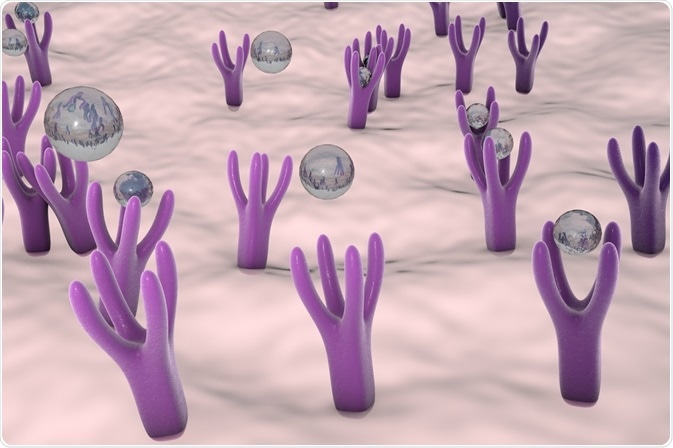What are peptide decoys and how are they used?
Peptide decoys or decoy receptors are molecules specifically designed to mimic the role of a certain receptor protein, encouraging target entities to interact with them so that these interactions can be studied and analyzed, or even exploited to initiate a certain activity or response.

Image Credit: Kateryna Kon/Shutterstock.com
To facilitate their uptake into the target cells, they are usually conjugated to a specific cell-penetrating peptide or monoclonal antibody.
They can be used for a variety of purposes, and are designed to suit each specific situation. In recent years much research has been published describing how peptide decoys can offer new therapeutic approaches for the treatment of a wide range of illnesses.
They are also being used to explore and deepen our understanding of several biological systems. We will discuss these below, detailing how peptide decoys were used in each case.
Cancer
Recent research has demonstrated the successful use of peptide decoys in assisting the development of potential new therapies for cancer. A paper published this month in the journal Drug Discovery Today outlines how peptide decoy technology has advanced and established itself as a novel therapeutic approach for breast cancer.
There are many types of breast cancer, and some of them are resistant to available therapies or are considered to be incurable. Given that breast cancer is the most prevalent type of cancer amongst women, researchers are striving to develop more effective therapeutic approaches that can improve treatment outcomes.
The study published on Drug Discovery Today has shown that peptide decoys can suppress oncogenic signaling pathways through a high-affinity interaction with specific ligands (such as inflammatory cytokines) that are involved in the pathogenesis of breast cancer.
Also, previous studies have shown the effectiveness of peptide decoys in targeting other forms of cancer, with some studies suggesting that they could potentially be used in the future to develop vaccines and cancer immunotherapies.
Hemophilia A
Other recent studies have suggested novel approaches to treat hemophilia A by neutralizing pathologic antibodies with peptide decoys.
Hemophilia is an inherited disorder that can be fatal. Its symptoms are a result of factor VIII (FVIII) deficiency. It has been observed that patients with hemophilia develop anti-FVIII antibodies that inhibit FVIII procoagulant activity.
Research has shown that peptide decoys can be used to neutralize the activity of FVIII inhibitors, allowing for an increase in FVIII activation and reducing symptoms of the illness.
While research is still in its early stages, it is thought that peptide decoys could be developed to create new therapeutic approaches for neutralizing pathologic antibodies.
Pain modulation
Research has also shown that peptide decoys can be used in deepening our knowledge of pain modulation and may even open the door to new pharmacological targets to reduce pain.
Mounting evidence has implicated a role for the interaction between the signaling adapter protein known as Toll-like receptor (TLR) and Toll/Interleukin-1 Receptor (TIR) in the modulation of pain by the sensory neurons.
It has been observed that after ligand interaction with TLRs, intracellular signaling is activated by TIR, which also initiates the activation of signaling adapter proteins. While TLR and TIR have long been known to be vital to TLR signaling cascades, the exact function of these receptors in pain modulation had remained elusive.
Recent research using peptide decoys has addressed this gap in knowledge.
Scientists have used modified TLR TIR decoy peptides to discover that these domains affect LPS-induced intracellular calcium flux and excitation in sensory neurons, leading to induced tactile allodynia (pain sensitization).
Through the use of peptide decoys, scientists were able to determine that the TLR TIR domains may serve as new pharmacological targets for pain relief.
Proteomics
Proteomics, the study of proteomes and their functions, has also benefited greatly from the use of peptide decoys. Large scale proteome analyses that use tandem mass spectrometry rely heavily on accurate tools for the estimation of incorrect identifications of proteins and peptides.
The use of peptide decoys has emerged as an effective approach to producing these essential estimations. The method is relatively simple: purposefully incorrect decoys are added into sequences and they correspond with incorrect search results in the search space that may have been considered correct.
This method has become firmly established in proteomics, enabling researchers to accurately estimate incorrect results and use decoys to design filtering criteria.
Summary
While this is not an exhaustive list of peptide decoys applications, it demonstrates the wide range of therapeutic opportunities that these molecules can offer.
We can expect peptide decoys technology to continue being used in biological and medical research, particularly in the early stages of drug development, a sector where it has found much success so far.
Sources:
- Allette, Y., Kim, Y., Randolph, A., Smith, J., Ripsch, M. and White, F. (2017). Decoy peptide targeted to the Toll-IL-1R domain inhibits LPS and TLR4-active metabolite morphine-3 glucuronide sensitization of sensory neurons. Scientific Reports, 7(1). https://www.nature.com/articles/s41598-017-03447-9#citeas
- Mahjoubin-Tehran, M., Rezaei, S., Jalili, A., Aghaee-Bakhtiari, S., Orafai, H., Jamialahmadi, T. and Sahebkar, A. (2020). Peptide decoys: a new technology offering therapeutic opportunities for breast cancer. Drug Discovery Today. https://www.sciencedirect.com/science/article/pii/S1359644620300362
- Villard, S., Lacroix-Desmazes, S., Kieber-Emmons, T., Piquer, D., Grailly, S., Benhida, A., Kaveri, S., Saint-Remy, J. and Granier, C. (2003). Peptide decoys selected by phage display block in vitro and in vivo activity of a human anti-FVIII inhibitor. Blood, 102(3), pp.949-952. ashpublications.org/.../Peptide-decoys-selected-by-phage-display-block-in
- Yadav, A., Kumar, D., and Dash, D. (2012). Learning from Decoys to Improve the Sensitivity and Specificity of Proteomics Database Search Results. PLoS ONE, 7(11), p.e50651. journals.plos.org/plosone/article?id=10.1371/journal.pone.0050651
Further Reading